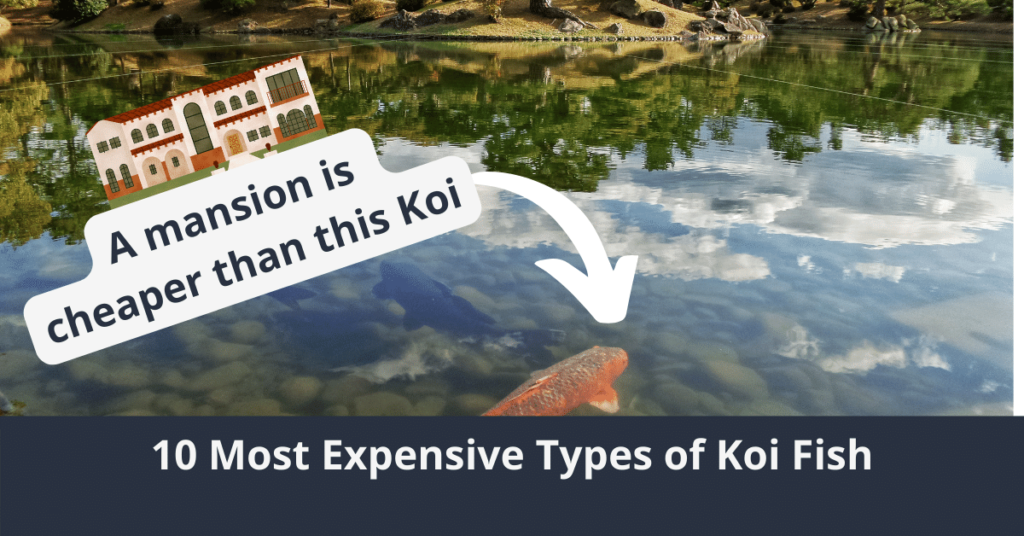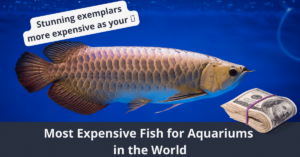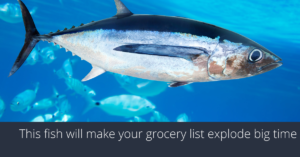Do you know what type of koi fish sold for $1.8 million in 2017? Let’s take a look at the top 10 most expensive koi fish, starting with the priciest koi ever sold and finishing with some truly honorable mentions.
Everything you will learn here
Top 10 Most Expensive Koi Fish
There are more than a hundred different types of koi fish in the world, and some of them sell for several hundreds of thousands (or millions) of dollars. Understanding the basic breeds can be challenging, as there is an astounding amount.
However, the koi fish pricing system is fairly straightforward. Buyers pay more for large, high-quality, and aesthetically-pleasing koi fish. Let’s look at some of the top options.
1. Kohaku
The most expensive koi fish ever sold was a female Kohaku koi named S Legend. This koi (whose body spanned more than three feet in length) sold for a whopping $1.8 million, officially placing it into the top tier for expensive koi fish.
The Kohaku variety sports a white body with vibrant orange-red splashes that cover its spine, abdomen, fins, and head. It’s an ornamental variety of koi, and it may be the oldest human-bred type of ornamental koi in the world.
These fish range in size from less than one inch to more than three feet in length, though it’s far rarer to see large Kohaku. Generally, koi lovers in the United States can expect to spend between $100 and $15,000 per Kohaku koi. Prices vary depending on lineage, size, and coloration.
2. Tancho
The Tancho koi typically have smooth white bodies that are flawless and unmarked. However, at the top of their heads, they sport a large and unmistakable orange-red mark, circle, or splotch. The coloration of Tancho koi is, therefore, very similar to the coloration of Kohaku varieties.
Still, the placements of the colors – and price! – are what differentiate this variety from similar ones. Tancho koi that are exceptionally large and eye-catching can easily sell for upwards of $3,000. Still, most buyers could get a great deal on a Tancho that costs $1,000 or less.
3. Showa
If calico cats had an aquatic equivalent, they might be Showa koi. That’s because these koi are known for their swirl and patches of three dominant colors. While these colors aren’t precisely the same as those found in calico cats, their number and style do show some similarities.
Showa koi are almost always black, orange-red, and white. The precise amounts of each color vary from specimen to specimen, as does the placement of the colors. Consequently, the most prized and expensive Showa koi tend to exhibit patterns that are tremendously eye-pleasing. They also tend to be quite large.
Buyers interested in acquiring a Showa koi may want to have between $200 and $16,000 ready for the purchase. If you’re less concerned about size and looks, a few hundred dollars may help you acquire a Showa koi. But if you’re determined to only buy the biggest and best, you’ll need to shell out a few thousand at the very minimum.
4. Doitsu
The Doitsu variety is one of the priciest and most beloved in the world. They’re also called German Koi, and they have very few scales. This makes them one of the least-shiny types of koi.
They’ve been so heavily interbred with other types of koi that it is nearly impossible to pinpoint a precise breed standard in terms of coloration. However, white, black, and orange varieties (much in the vein of Showa or Sanke koi) tend to be some of the common types of Doitsu koi fish.
Doitsu with darker colorations and smaller body sizes may sell for only $200. However, those with interesting, bright color patterns and longer bodies may retail for $3,000 or more. “Shiny” Doitsu koi are particularly rare and pricey due to the natural dull nature of this koi’s skin and scales.
5. Sanke
Sanke koi, like the Kohaku and the Doitsu, are fantastically popular. They’re nearly identical to Showa koi, which can make them challenging to identify. Still, there’s one easy-to-spot difference between these varieties: head coloration and marking.
Showa koi may have three distinct colors on their heads. But Sanke koi only have two colors present on their heads: red and white. So if you spot a calico-esque koi with a white, black, and red body but only red and white on its head, you’re likely looking at a Sanke.
A six-inch Sanke koi might sell for as little as $200. However, a more robust specimen could easily fetch upwards of $6,000. Consequently, Sanke koi are some of the most expensive types of koi currently available.
6. Ogon
While all the shimmers may not be gold, most Ogon koi are a metallic, unmistakable shade of gold or yellow. Some, known as Platinum Ogon, might be a shining white color. Still, nearly all varieties of Ogon are remarkably luminescent, and they shimmer brightly beneath the water’s surface.
This unique feature makes them distinct and memorable additions to any koi pond. Depending on the age, size, and precise coloration of an Ogon koi, sellers may be able to earn upwards of $2,000 per fish. Naturally, specimens with lackluster coloration or unimpressive girth may sell for as little as $200.
When it comes to the Ogon koi market, the fish that tend to fetch the highest prices are the Ginrin and Matsuba sub-varieties and hybrids. These koi are often gorgeously gold with some black lining around each shiny scale.
7. Matsuba
The Matsuba variety of koi are substantially more varied than many other varieties. They come in a wide range of colors and potential patterns, making them one of the more challenging varieties to define. Still, Matsuba koi are prominent options within the koi market, and they seem to be growing ever more popular and pricey.
Traditionally, Matsuba koi have a solid metallic base coloration that’s overlaid with a black pattern. Still, both coloration and pattern can vary greatly among this variety. Prices also vary greatly for Matsuba koi. Some of the smaller specimens may sell for as little as $50.
However, Matsuba koi with striking colorations or prize-winning ancestry may sell for hundreds of dollars, if not thousands. Additionally, larger Matsuba tend to garner higher prices. After all, who doesn’t enjoy the idea of a three-foot-long koi in the backyard pond?
8. Asagi
The Asagi koi exhibits shimmering blue scales reminiscent of lapis lazuli stones. However, they also feature orange and white coloration. Still, purebred Asagi tend to be primarily blue and exceptionally luminous.
Young specimens don’t tend to retail for as much as older ones, especially since much of the Asagi pigmentation occurs as the fish ages. This is particularly true of the two-toned effects on their back, and side scales also develop in adulthood.
Silvery metallic Asagi may sell for between $600 and $3,000. The more traditional blue-toned can fetch similar prices, although the range is slightly larger. Small specimens may fetch as little as $100, but larger and older Asagi koi can easily sell for upwards of $3,000.
9. Utsuri
Utsuri koi sport sleek black bodies and at least one other non-metallic coloration. For example, they can have mostly black bodies with white, orange, or yellow coloration that blends and melds with the darker hues.
The pattern style of the Utsuri koi is often associated with the traditional concept of yin and yang. That’s because half of an Utsuri’s body may be primarily one color (black), with the other being almost entirely the alternative color (orange, yellow, or white).
The prices associated with these types of koi range drastically from $150 to $3,000, or even more. Exact prices typically depend on the size, age, lineage, and look of each specimen. Larger, hardier Utsuri with well-defined colorations are bound to fetch higher prices.
10. Kikokuryu
The Kikokuryu is a fantastically popular variety of koi thanks to its shimmering, silvery body and bright orange coloration. Some Kikokuryu also have white and black areas across their noticeably platinum scales.
These fish shine and shimmer beneath the water, adding to their aesthetic value. Kikokuryu that are less than a foot in length or that have somewhat muddled coloration may sell for as little as $300.
However, handsome and well-bred Kikokuryu can sell for $1,000. Those with impressive lineages to boot may fetch upwards of $2,000. As such, this variety is certainly one of the pricier ones.
Honorable Mentions
Though the above koi types all fetch relatively high prices, they aren’t the only varieties that can sport steep price tags. Some additional varieties known for their wealthy fanatics include:
- Chagoi
- Koromo
- Bekko
- Shusui
- Goshiki
Naturally, many breeders combine different varieties of koi to create distinct species or please the preferences of specific buyers. As such, the most expensive sub-varieties or hybrids of koi are continually changing and updating.
You might also be interested in reading the related articles to know more:
Final Thoughts
If you’re thinking of installing a koi pond in your backyard, you may want to consider what expenses may lay outside the initial building and installation process. After all, koi fish can be fantastically pricey. If you’re hoping to acquire a Kohaku, Tancho, Showa, Sanke, or Doitsu koi, you might want to start saving right away!



